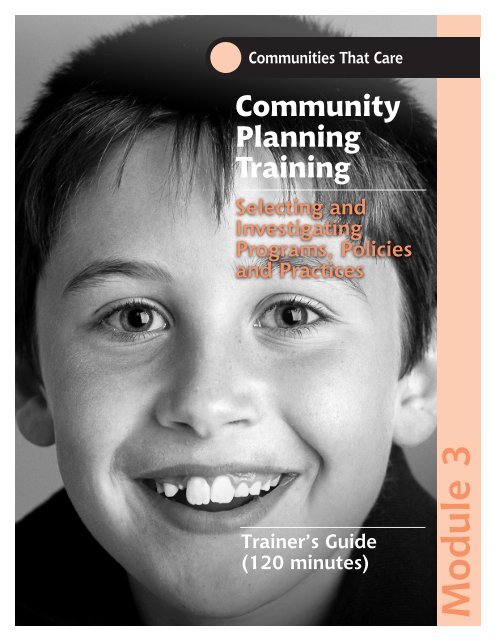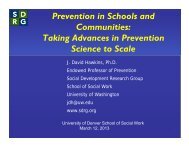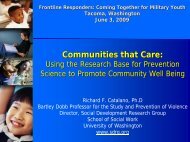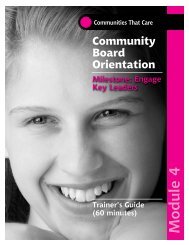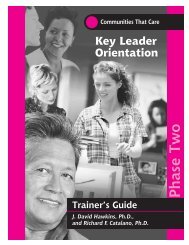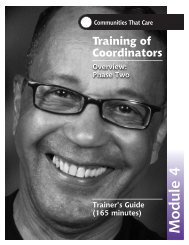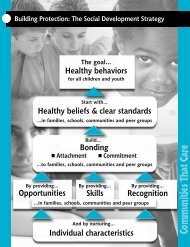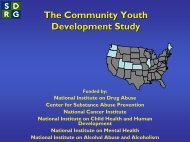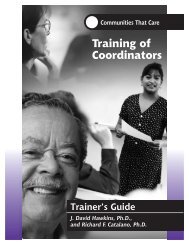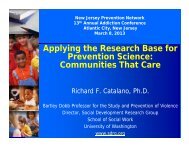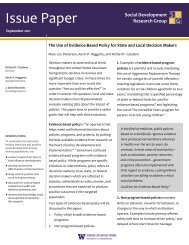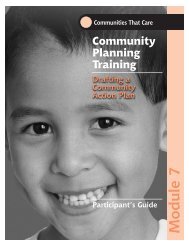CPT Training Guide Module 3
CPT Training Guide Module 3
CPT Training Guide Module 3
You also want an ePaper? Increase the reach of your titles
YUMPU automatically turns print PDFs into web optimized ePapers that Google loves.
Communities That Care<br />
Community<br />
Planning<br />
<strong>Training</strong><br />
Selecting and<br />
Investigating<br />
Programs, Policies<br />
and Practices<br />
Trainer’s <strong>Guide</strong><br />
(120 minutes)<br />
<strong>Module</strong> 3
Slides for <strong>Module</strong> 3<br />
<strong>Module</strong> 3......................................................................... 3-1<br />
We are here. ................................................................... 3-2<br />
<strong>Module</strong> 3 goal................................................................. 3-3<br />
Objectives ....................................................................... 3-4<br />
Successful Community Action Plans ............................. 3-5<br />
Community Action Plans identify ways to: .................... 3-6<br />
Meeting criteria ............................................................... 3-7<br />
Communities That Care Prevention<br />
Strategies: A Research <strong>Guide</strong> To What Works ................ 3-8<br />
Developmental Cross-Reference Charts........................ 3-9<br />
Risk- and Protective-Factor Cross-Reference Charts .... 3-10<br />
Activity: Identify gaps, issues and barriers<br />
to address by expansion or modification....................... 3-11<br />
Investigating existing<br />
community resources..................................................... 3-12<br />
Activity: Part 1—Identify tested, effective prevention<br />
strategies and programs, policies and practices........... 3-13<br />
Critical program components......................................... 3-14<br />
Activity: Part 2—Identify tested, effective prevention<br />
strategies and programs, policies and practices........... 3-15<br />
3—2
Slides for <strong>Module</strong> 3<br />
Communities That Care<br />
Appropriateness of your programs,<br />
policies and practices..................................................... 3-16<br />
Implementation costs ..................................................... 3-17<br />
Resources, skills and time available .............................. 3-18<br />
Social and political issues .............................................. 3-19<br />
Activity: Identify social and political issues .................... 3-20<br />
Next up ........................................................................... 3-21<br />
Mouse-Click Icon<br />
(for a computer-based presentation)<br />
The mouse-click icon shows you what information will come up on<br />
the slide when you click. (Some slides use several clicks.)<br />
3—3
<strong>Module</strong> 3<br />
Slide 3-1<br />
Notes<br />
Mental Set: Cooperation<br />
Time: 10 minutes<br />
Let’s start this module with an activity.<br />
Please get into pairs and face away from each other. Imagine that each of<br />
you has been accused of a crime and brought into a separate room for<br />
interrogation. You have each been given two options: you can either confess<br />
to the crime or stay silent. If you both stay silent, you both get to go free, as<br />
there is no evidence against you. If you both confess, you both get 10 years<br />
in prison. If one of you confesses, the confessor will get to go free and the<br />
one who stays silent will get 20 years in prison.<br />
With these conditions in mind, each person write down what you would do on<br />
a sheet of paper. Remember, there can be no contact between people.<br />
Show each other your answers. Now, knowing the previous outcome, play<br />
again. Keep playing until you recognize a pattern and can make the best<br />
possible choice for yourself and your partner.<br />
Debrief: At first, it appears that the best choice is to confess—this decision<br />
has your own best interest in mind. But the person you are playing with is<br />
most likely thinking the same way. More often than not, both players will act in<br />
their own self-interest at first, for fear of being exploited. It becomes clear after<br />
playing several times, however, that cooperation is the best choice. The<br />
object of repeated play is to minimize your combined amount of jail time.<br />
Exploiting your partner is not the best long-term decision. Working together to<br />
maximize both players’ outcome is the best solution.<br />
3—4
Communities That Care<br />
Now, I’d like you to raise your hand if you think you might have problems with<br />
securing resources as you begin developing and implementing a focused<br />
action plan in your community. (Show of hands.) Raise your hand if you think<br />
the existing programs and services in your community are going to be<br />
competing for fewer and fewer dollars in the next 5 years. (Show of hands.)<br />
Raise your hand if you envision an increasing need for programs and services<br />
in the next few years. (Show of hands.)<br />
The activity you just did is a variation of a game called “The Prisoner’s<br />
Dilemma,” devised in 1950 by two scientists named Merrill Flood and Melvin<br />
Dresher who worked for the RAND Corporation. The activity helps make several<br />
points that can be useful when faced with the possible problems of community<br />
planning. Community members need to think “out of the box” when coming up<br />
with solutions. You need to focus on possibilities rather than obstacles,<br />
understand those problems from points of view other than your own and be<br />
willing to change your strategies over time if they don’t work as well as others.<br />
Keep these points in mind as we begin talking about responding to priorities by<br />
strengthening and enhancing existing resources and implementing tested,<br />
effective strategies to fill gaps in programs and services.<br />
Notes<br />
3—5
<strong>Module</strong> 3<br />
Slide 3-2<br />
Notes<br />
Let participants know that you will be covering the milestone<br />
“Select tested, effective programs, policies and practices to<br />
address priority risk and protective factors and fill gaps” in this module.<br />
3—6
Communities That Care<br />
Slide 3-3<br />
Notes<br />
Review the goal.<br />
3—7
<strong>Module</strong> 3<br />
Slide 3-4<br />
Notes<br />
Review the objectives.<br />
3—8
Communities That Care<br />
Slide 3-5<br />
Notes<br />
Objective 1: Describe the components of a successful<br />
Community Action Plan.<br />
As you learned in the first module, there are several factors that go into having<br />
a successful Community Action Plan. Let’s review the key points.<br />
Review each item as you click it onto the screen.<br />
Building on results from your community assessment is key<br />
to having a successful Community Action Plan. This means<br />
your plan needs to:<br />
• address priority risk factors<br />
• build on the strengths and resources of<br />
your community<br />
• address areas where your community may be<br />
in need of further resources or ways to<br />
overcome roadblocks.<br />
A successful plan identifies specific desired outcomes and<br />
evaluation methods. This allows you to focus your efforts on<br />
meeting desired outcomes and to measure your progress<br />
along the way.<br />
Your plan needs to include research-based, tested, effective<br />
programs, policies and practices to guide your community’s<br />
prevention efforts.<br />
3—9
<strong>Module</strong> 3<br />
Slide 3-6<br />
Notes<br />
Objective 1: Describe the components of a successful<br />
Community Action Plan.<br />
Let’s review how your Community Action Plan can help guide you in<br />
implementing strategies for achieving your community-level outcomes.<br />
• Your Community Action Plan will propose ways that existing programs,<br />
policies and practices can be modified to effectively address your priority<br />
risk factors and enhance protective factors. You’ll remember that back in<br />
<strong>Module</strong> 1, I gave an example of how you could modify an existing visiting<br />
nurses program that uses an unevaluated approach by retraining the<br />
nurses to use the tested, effective David Olds’ Nurse-Family<br />
Partnership program.<br />
• Your plan will propose how existing, effective resources can be<br />
expanded to reach all those who need them. You can use the results of<br />
your community resources assessment to see where programs, policies<br />
and practices can help fill gaps. This will also allow you to see where<br />
resources are needed for implementation.<br />
• Your plan will identify new tested, effective programs, policies and<br />
practices to fill gaps in existing services, and outline plans for<br />
implementation.<br />
• Your plan will also recommend systems-change strategies—these are<br />
systemic changes that can either improve service delivery in existing<br />
programs or facilitate the implementation of new programs.<br />
3—10
Communities That Care<br />
Slide 3-7<br />
Notes<br />
Objective 2: Identify relevant tested,<br />
effective prevention strategies.<br />
Let’s take a look at Communities That Care Prevention Strategies:<br />
A Research <strong>Guide</strong> To What Works. All programs in the guide meet the<br />
following criteria:<br />
Read each item as you click it onto the screen and elaborate as follows:<br />
They address research-based priority risk factors for<br />
substance abuse, delinquency, teen pregnancy, school<br />
drop-out or violence.<br />
They increase protective factors. That is, they strengthen<br />
healthy beliefs and clear standards for behavior, build<br />
bonding to family, community, school and positive peers,<br />
and provide opportunities, skills and recognition for<br />
young people’s involvement in their communities,<br />
schools and families.<br />
They intervene at developmentally appropriate ages.<br />
They have demonstrated significant effects on risk and<br />
protective factors or health and behavior problems in<br />
high-quality research tests.<br />
3—11
<strong>Module</strong> 3<br />
Slide 3-8<br />
Notes<br />
Objective 2: Identify relevant tested, effective prevention strategies.<br />
Note to trainers: Ask participants to follow along in their guides as you review the organization.<br />
Review the slide.<br />
The beginning section of the guide has four areas of interest:<br />
• a table of contents listing all of the programs<br />
• a grid that lists all of the programs and the risk factors addressed by each<br />
• a brief overview of the Communities That Care process<br />
• an overview of the guide and how it is structured.<br />
The body of the guide is divided into four focus areas: Family Focus, School Focus, Community-Based<br />
Youth Programs Focus and Community Focus.<br />
Within each focus area, there are a number of broad program strategies. For example, the first strategy in the<br />
Family Focus area is Marital Therapy. There is a description of the overall strategy (Marital Therapy) and the<br />
risk factor addressed by this strategy (Family Conflict).<br />
Within each strategy, there are example programs. Can someone tell me the name of the program in the<br />
Marital Therapy strategy?<br />
The “developmental period” bar above each program identifies the age groups for which the program has been<br />
tested. Next to each program name, you’ll see a series of circles with letters inside. Those give you further<br />
information about the resources available for the program. (See the key on the previous page.) For each program,<br />
you’ll find the risk and protective factors addressed, a description of the program and references. Some program<br />
descriptions also include a list of resources.<br />
Note to trainers: Make sure participants understand what resources are available for each program.<br />
For example, some programs provide training and materials, but not a curriculum or technical assistance.<br />
This could affect program selection.<br />
3—12
Communities That Care<br />
Slide 3-9<br />
Notes<br />
Objective 2: Identify relevant tested,<br />
effective prevention strategies.<br />
Your guide also contains two appendices. Appendix A includes some<br />
cross-reference charts, and Appendix B includes a list of references.<br />
Let’s take a closer look at the cross-reference charts.<br />
There are two sets of charts. The first set is made up of five Developmental<br />
Cross-Reference Charts. These charts list the developmental periods from<br />
the prenatal period to age 18. For each developmental period, you’ll see a<br />
list of all of the strategies that are appropriate for that period, along with the<br />
risk and protective factors addressed by each strategy.<br />
Developmental Cross-Reference Charts can be used to help you identify<br />
tested, effective programs, policies and practices to fill developmental gaps<br />
identified in your Resources Assessment Report.<br />
For example, let’s say your report shows that there are no tested, effective<br />
programs in your community that address family conflict for the prenatal to<br />
two-years developmental period. This chart shows that, for family conflict,<br />
the guide identifies effective programs, policies and practices for three<br />
general strategies: Marital Therapy, Prenatal/Infancy Programs and Parent<br />
<strong>Training</strong>. The chart lists page numbers for detailed sections on each strategy.<br />
Each section includes a description of the strategy, followed by descriptions<br />
of relevant tested, effective programs, policies and practices.<br />
Are there any questions about how the Developmental Cross-Reference<br />
Charts can be used?<br />
3—13
<strong>Module</strong> 3<br />
Slide 3-10<br />
Notes<br />
Objective 2: Identify relevant tested,<br />
effective prevention strategies.<br />
Four Risk- and Protective-Factor Cross-Reference Charts make up the<br />
second set of charts in Appendix A.<br />
As you know, there are four domains of influence in children’s lives: family,<br />
community, school, and peer and individual. This first chart shows the risk<br />
factors associated with the family domain.<br />
The risk factors associated with each domain are in the left-hand column.<br />
These correspond to the program strategy that best addresses each risk<br />
factor in the next column to the right. These are followed by several<br />
protective factors. The check marks show which protective factors the<br />
program strategy addresses.<br />
The final two columns show the developmental period (the age group for<br />
which the program has been tested) and the page number that corresponds<br />
with the program strategy for that particular row.<br />
Are there any questions about how the charts are set up?<br />
Note to trainers: A review of available program materials and evaluation<br />
reports was used to determine which protective factors each program<br />
strategy addresses. It is possible that a program strategy addresses<br />
additional protective factors, but there was insufficient information available<br />
to make that determination.<br />
3—14
Communities That Care<br />
Slide 3-11<br />
Notes<br />
Objective 2: Identify relevant tested, effective prevention strategies.<br />
Listed on the Strategic Planning Worksheet are your priority risk factors and the gaps, issues and barriers in<br />
addressing those risk factors. This information is included in your Resources Assessment Report. You may be able<br />
to address some of these gaps by expanding or modifying existing, effective community resources, rather than<br />
implementing new tested, effective programs, policies and practices.<br />
In this activity, you will determine what gaps, issues and barriers can be addressed by expanding or modifying<br />
existing, effective resources. For example, a sector gap occurs if a tutoring program is offered at the public library<br />
but not in the schools. You might determine that it would be more practical to make the existing tutoring program<br />
available to schools rather than implement a new tutoring program.<br />
Note to trainers: Explain to participants that many of their existing community resources may not have been<br />
tested for effectiveness. This doesn’t necessarily mean those programs are ineffective or that they should try to<br />
replace all of them with tested, effective programs. However, if they choose to expand an existing program or<br />
implement a new program, it should be one that has already been tested and shown to be effective. Over time, as<br />
new tested, effective programs become part of the community, the community may want to consider<br />
reprogramming or realigning existing resources to support tested, effective programs.<br />
Activity: Identify gaps, issues and barriers to address by expansion or modification<br />
Time: 15 minutes<br />
Instructions:<br />
• Divide participants into groups of three. Have each group choose a gap, issue or barrier. (Trainer should<br />
ensure that all of the gaps are covered.)<br />
• Using the results of the Resources Assessment Report, determine the nature of each gap, issue or barrier and<br />
if it can be addressed by modifying or expanding existing, effective resources.<br />
• Have participants report-out to the larger group. Highlight the gaps on the Strategic Planning Worksheet that<br />
can be addressed through modification or expansion.<br />
3—15
<strong>Module</strong> 3<br />
Slide 3-12<br />
Notes<br />
Objective 2: Identify relevant tested,<br />
effective prevention strategies.<br />
Expanding or modifying an effective community resource may be an easy<br />
task since you have already identified the nature of the gap, issue or barrier.<br />
For example, a geographic gap occurs when a program that works to reduce<br />
the availability of alcohol to adolescents is available only in the largest city in<br />
the county and not in outlying rural areas. To address this gap, you simply<br />
may need to expand this program so that it reaches the areas in need.<br />
Some effective community resources may require a more complex expansion<br />
or modification. Yet there are some basic questions you should ask when<br />
investigating whether to expand or modify any existing, effective community<br />
resource. They include:<br />
• What type of modification or expansion is required?<br />
• What level of support exists from the program providers for modification<br />
or expansion?<br />
• Are there any special requirements for expansion or modification, such as<br />
training new staff or providing transportation, and are they feasible?<br />
• What are the costs of modification or expansion and are they feasible?<br />
As you continue your work after this training, use the Existing, Effective<br />
Resources Worksheet in your Participant’s <strong>Guide</strong> to help investigate<br />
expanding or modifying your community resources. After an investigation,<br />
you may feel that implementation of a new tested, effective program,<br />
policy or practice would be a better way to address the gap, issue or barrier.<br />
3—16
Activity<br />
Existing, Effective Resources Worksheet<br />
Type of<br />
modification<br />
or expansion<br />
Communities That Care<br />
Community Community Community<br />
Resource 1 Resource 2 Resource 3<br />
Level of<br />
support<br />
Special<br />
requirements<br />
Costs of<br />
expansion<br />
or modification<br />
3—17
<strong>Module</strong> 3<br />
Slide 3-13<br />
Notes<br />
Objective 2: Identify relevant tested,<br />
effective prevention strategies.<br />
Now let’s turn our attention to addressing those gaps that will require you to<br />
select and later implement a strategy and new tested, effective programs,<br />
policies and practices.<br />
We’ll be doing a two-part activity. The first part involves using the Risk- and<br />
Protective-Factor Cross-Reference Charts in your prevention strategies guide.<br />
Activity: Part 1—Identify tested, effective prevention<br />
strategies and programs, policies and practices<br />
Time: 5 minutes<br />
Instructions:<br />
• Have participants continue to work in their groups of three. Assign each<br />
group a gap, issue or barrier, along with its corresponding risk factor.<br />
• Have participants turn to the Risk- and Protective-Factors Cross-<br />
Reference Charts in their prevention strategies guide. Have each group<br />
identify one possible strategy for the gap, issue or barrier addressing<br />
their priority risk factor. Ask them to highlight the strategy.<br />
Note to trainers: Have groups stay together as you review the next slide.<br />
These same groups will work together in the second part of the activity.<br />
3—18
Communities That Care<br />
Slide 3-14<br />
Notes<br />
Objective 2: Identify relevant tested,<br />
effective prevention strategies.<br />
Before we go on to Part 2 of our activity, let’s take a closer look at the<br />
prevention strategies guide. The guide includes a description of each<br />
program, policy and practice within a prevention strategy. Each description<br />
may include several of these components:<br />
Note to trainers: Ask participants to open their prevention strategies guide<br />
to a program that you’ve selected to use as a model. Go through the<br />
program description, pointing out each of the components.<br />
• Risk and protective factors addressed<br />
• How and with whom the program was conducted<br />
• Target population<br />
• Program evaluation<br />
• Results<br />
3—19
<strong>Module</strong> 3<br />
Slide 3-15<br />
Notes<br />
Objective 2: Identify relevant tested, effective prevention strategies.<br />
Now let’s put this kind of information to use to identify tested, effective programs, policies and practices to<br />
investigate for your community.<br />
Note to trainers: Remind participants that available resources for programs listed in the guide vary.<br />
They can determine what resources are available by checking the symbols that appear by each program name.<br />
Participants should keep available resources in mind when they select their programs, policies or practices.<br />
Activity: Part 2—Identify tested, effective prevention strategies and programs,<br />
policies and practices<br />
Time: 30 minutes<br />
Instructions:<br />
• Have participants continue to work in their groups of three. Have them review the program descriptions for the<br />
strategies they identified in Part 1 of this activity. Tell them to find a program, policy or practice that their community<br />
could use to fill the gaps addressing their priority risk factors for their selected strategies. Have them highlight the<br />
name of the program.<br />
(Be sure participants understand that if a priority risk factor is currently being addressed by a community resource,<br />
their selections should work with the existing resource to fill gaps, and not overlap or duplicate its functions.)<br />
• Have them identify and highlight the critical components of each selection.<br />
• Tell each group to report-out to the large group and share the selection. List each selection on the easel sheet<br />
copy of the Strategic Planning Worksheet.<br />
Note to trainers: Let participants know that these selections are preliminary. The group will now learn how to further<br />
investigate their programs, policies or practices. This investigation will take place in the community and should be<br />
completed before the program, policy and practice selections are finalized in the Community Action Plan.<br />
3—20
Communities That Care<br />
Slide 3-16<br />
Notes<br />
Objective 3: Further investigate tested,<br />
effective programs, policies and practices.<br />
You will now learn how to further investigate your preliminary program,<br />
policy and practice selections.<br />
Just because a program has worked in other communities or under<br />
controlled research conditions does not mean it will work in your community.<br />
This is why determining appropriateness is important. You can determine the<br />
appropriateness of your selected programs, policies and practices by asking<br />
this simple question:<br />
• Will the program, policy or practice have a high probability of success in<br />
my community?<br />
To answer this question, you need to investigate how well your selected<br />
programs, policies and practices will work with your community’s unique<br />
strengths and needs. You should do this by considering the following:<br />
• implementation costs<br />
• resources, skills and time available for implementation<br />
• social and political issues.<br />
This investigation will take place later in your community. Here, you will learn<br />
how to conduct your investigation and will become familiar with the<br />
worksheets you will be using to gather your information.<br />
3—21
<strong>Module</strong> 3<br />
Slide 3-17<br />
Notes<br />
Objective 3: Further investigate tested, effective programs, policies and practices.<br />
Before selecting your programs, policies and practices, you need to have a sense of their implementation costs.<br />
This could have an impact on what programs, policies and practices you are able to select. Implementation costs<br />
may vary from program to program. Here are some types of expenses for each program you are considering:<br />
• Staff costs—This may include salaries or possible traveling expenses. It may also include costs for<br />
education and/or licensing fees, depending on your staff’s qualifications.<br />
• <strong>Training</strong> costs—Depending on the program you choose, there may be training costs to pay. This can be determined<br />
by identifying the available resources for each program.<br />
• Supplies and materials—Materials may include handouts, writing materials, books or kits.<br />
• Equipment and facilities—You may need special equipment for some programs, policies and practices, including<br />
computers or projection screens. You may also need to locate places where program training can take place.<br />
• Administration—You may need to have program administrators to oversee the program.<br />
• Technical assistance—Assistance may be needed to set up and maintain programs.<br />
• Substitutes or staff replacements—This expense may be required if your staff needs to be covered while they are at<br />
trainings or meetings related to the new strategies.<br />
• Transportation—You may need to provide transportation for staff, participants or both. This may prove challenging in<br />
smaller or rural communities.<br />
• Costs over time—Finally, you may need to determine how much the program will cost to maintain over time.<br />
As you continue your work after this training, you can use the Implementation Costs Worksheet in your Participant’s<br />
<strong>Guide</strong> to estimate the costs of your selected programs, policies and practices. This will help determine whether your<br />
selections are feasible or too expensive.<br />
3—22
Activity<br />
Implementation Costs Worksheet<br />
Staff costs<br />
Communities That Care<br />
Program, Policy or Program, Policy or Program, Policy or<br />
Practice 1 Practice 2 Practice 3<br />
<strong>Training</strong> costs<br />
Supplies and<br />
materials<br />
Equipment<br />
and facilities<br />
Administration<br />
Technical<br />
assistance<br />
Staff<br />
replacements<br />
Transportation<br />
Costs over time<br />
3—23
<strong>Module</strong> 3<br />
Slide 3-18<br />
Notes<br />
Objective 3: Further investigate tested, effective programs, policies and practices.<br />
Resources, skills and timing issues are important factors to consider for implementation.<br />
• Resources—You have already selected programs, policies and practices to address priority risk factors that your<br />
community’s current resources either do not address, or do so inadequately because of gaps, issues and barriers.<br />
You will need to further investigate how the resources listed in your Resources Assessment Report could affect your<br />
selections before finally deciding upon programs, policies and practices to include in your Community Action Plan.<br />
For example, are there individuals in the community dedicated to youth development who will offer their time to help<br />
once the program is implemented? Or, if you already have staff that has access to a relevant population, could they<br />
be trained in the tested, effective program? This would eliminate a barrier to implementation. Barriers are possible if<br />
certain resources disagree with your selected programs.<br />
• Skills—Consider what credentials and expertise are needed for successfully implementing the programs, policies or<br />
practices you’ve selected. For example, let’s say that a program, policy or practice was shown effective under<br />
controlled experimental conditions being administered by people with master’s degrees. In order to implement a<br />
tested, effective program, policy or practice with fidelity, you would need to see whether there are people in your<br />
community who also have these credentials.<br />
• Timing issues—Consider when each stage of the implementation will occur and how much time is required between<br />
stages. For example, will implementation take place over the entire school year or only part? It’s best to have a<br />
general sense of these issues before selecting programs, policies and practices for your Community Action Plan.<br />
Use the Resources, Skills and Time Issues Worksheet in your Participant’s <strong>Guide</strong> to help keep track of these factors that<br />
may affect your selected programs, policies and practices. Each of these factors should be understood before writing<br />
your Community Action Plan.<br />
3—24
Activity<br />
Communities That Care<br />
Resources, Skills and Time Issues Worksheet<br />
Identify which of the following kinds of resources in your Resources Assessment Report will affect your<br />
selections of programs, policies and practices:<br />
Networks and organizations that foster collaboration and information sharing<br />
Staff with access to populations you want to serve<br />
Staff with skills that could be utilized for selected tested, effective programs<br />
Individuals in the community dedicated to youth development<br />
Funding sources and resource providers<br />
Programs or personnel that might be barriers to program implementation<br />
How will having or not having these resources affect the selection of your programs, policies and practices?<br />
Examine your selected programs, policies and practices. Determine if staff will need any special credentials<br />
or expertise for successful implementation.<br />
Determine when each stage of your selected program, policy or practice will take place.<br />
Program, policy or practice Stage of implementation When it will occur<br />
3—25
<strong>Module</strong> 3<br />
Slide 3-19<br />
Notes<br />
Objective 3: Further investigate tested,<br />
effective programs, policies and practices.<br />
Social and political issues are points of concern in the community that could<br />
affect your final selection of a program, policy or practice. They should<br />
therefore be carefully considered before drafting the Community Action Plan.<br />
Youth and community members are good sources of information for social<br />
and political issues you may face.<br />
Here are some examples where social or political issues could affect the<br />
implementation of programs, policies or practices:<br />
• A recent community event raises awareness about a specific issue in the<br />
community. This could be an issue that is new to the community, or one<br />
that has not yet been brought to the attention of community leaders.<br />
• Public sentiment clearly shows support for or opposition to a specific<br />
program, policy or practice.<br />
• A budget crisis in the school district is consuming the time and energy of<br />
school leaders. This could make a program requiring significant time and<br />
energy difficult to implement.<br />
• A new mayor or other city official is elected, reorganizing the city<br />
government. This could put program selection decisions on hold.<br />
• Recent immigration has brought the needs of this new population to the<br />
attention of community leaders. Any tested, effective program that does<br />
not meet the needs of this population could be problematic.<br />
3—26
Communities That Care<br />
Slide 3-20<br />
Notes<br />
Activity: Identify social and political issues.<br />
Time: 15 minutes<br />
Instructions:<br />
• Have participants continue to work in their groups of three. Ask each<br />
group to complete the Social and Political Issues worksheet in their<br />
Participant’s <strong>Guide</strong>.<br />
• Have each group report out to the larger group.<br />
Note to trainers: Let participants know that they can continue the process<br />
of identifying social and political issues by talking with other community<br />
leaders and community members, including youth.<br />
3—27
Activity<br />
Social and Political Issues Worksheet<br />
What social and political issues in the community could affect selection<br />
of programs, policies and practices?<br />
How could the identified social and political issues affect the implementation<br />
of selected programs, policies and practices?<br />
What support/opposition to any of the programs selected should we anticipate?<br />
What community resources could help with anticipated opposition?<br />
How can the community take advantage of anticipated support?<br />
3—28
Communities That Care<br />
Slide 3-21<br />
Notes<br />
Let participants know that in the next module, they will work on drafting<br />
participant and implementation outcomes.<br />
3—29
<strong>Module</strong> 3<br />
Notes<br />
3—30


